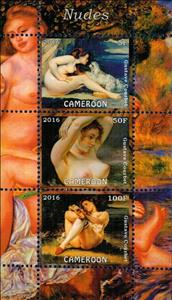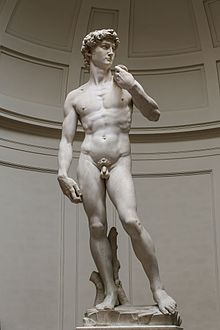Mini Sheet: Nudes (Cinderellas 2016)
Nudes (Cinderellas 2016)
01 January (Cinderellas ) within release Cameroon goes into circulation Mini Sheet Nudes face value 155 Central African CFA franc
| Mini Sheet Nudes in catalogues | |
|---|---|
| Colnect codes: | Col: CM 2016-04 |
Mini Sheet is square format.
This item was illegally produced without the authorization of the postal administration inscribed on the stamps. They have no postal validity.Also in the issue Cameroon:
- Stamp - Cats face value 200;
- Stamp - Cats face value 50;
- Mini Sheet - Cats face value 385;
- Stamp - Cats face value 20;
- Stamp - Cats face value 10;
- Stamp - Cats face value 5;
- Stamp - Cats face value 100;
- Mini Sheet - Dinosaurs face value 385;
- Stamp - Dinosaurs face value 5;
- Stamp - Dinosaurs face value 10;
- Stamp - Dinosaurs face value 20;
- Stamp - Dinosaurs face value 50;
- Stamp - Dinosaurs face value 100;
- Stamp - Dinosaurs face value 200;
- Mini Sheet - Dinosaurs face value 385;
- Stamp - Dinosaurs face value 5;
- Stamp - Dinosaurs face value 10;
- Stamp - Dinosaurs face value 20;
- Stamp - Dinosaurs face value 50;
- Stamp - Dinosaurs face value 100;
- Stamp - Dinosaurs face value 200;
- Mini Sheet - Dinosaurs face value 385;
- Stamp - Dinosaurs face value 5;
- Stamp - Dinosaurs face value 5;
- Stamp - Dinosaurs face value 10;
- Stamp - Dinosaurs face value 20;
- Stamp - Dinosaurs face value 50;
- Stamp - Dinosaurs face value 100;
- Stamp - Dinosaurs face value 200;
- Stamp - Dinosaurs face value 10;
- Stamp - Dinosaurs face value 20;
- Stamp - Dinosaurs face value 50;
- Stamp - Dinosaurs face value 100;
- Stamp - Dinosaurs face value 200;
- Mini Sheet - Dinosaurs face value 385;
- Mini Sheet - Nudes face value 155;
- Stamp - Nudes face value 5;
- Stamp - Nudes face value 50;
- Stamp - Nudes face value 100;
- Mini Sheet - Nudes face value 155;
- Stamp - Nudes face value 5;
- Stamp - Nudes face value 50;
- Stamp - Nudes face value 100;
- Mini Sheet - Nudes face value 155;
- Stamp - Nudes face value 5;
- Stamp - Nudes face value 50;
- Stamp - Nudes face value 100;
- Mini Sheet - Birds face value 385;
- Mini Sheet - Dinosaurs face value 385;
- Stamp - Dinosaurs face value 20;
|
Data entry completed
53%
|
|
|---|---|
| Mini Sheet Nudes in digits | |
| Country: | Cinderellas |
| Date: | 2016-01-01 |
| Print: | Offset lithography |
| Emission: | Незаконный |
| Format: | Mini Sheet |
| Face Value: | 155 Central African CFA franc |
Mini Sheet Nudes it reflects the thematic directions:
The domestic dog (Canis lupus familiaris or Canis familiaris) is a member of genus Canis (canines) that forms part of the wolf-like canids, and is the most widely abundant carnivore. The dog and the extant gray wolf are sister taxa, with modern wolves not closely related to the wolves that were first domesticated. The dog was the first domesticated species and has been selectively bred over millennia for various behaviors, sensory capabilities, and physical attributes. Their long association with humans has led dogs to be uniquely attuned to human behavior and they are able to thrive on a starch-rich diet that would be inadequate for other canid species. Dogs vary widely in shape, size and colours. Dogs perform many roles for people, such as hunting, herding, pulling loads, protection, assisting police and military, companionship and, more recently, aiding handicapped individuals. This influence on human society has given them the sobriquet "man's best friend".
The nude, as a form of visual art that focuses on the unclothed human figure, is an enduring tradition in Western art. It was a preoccupation of Ancient Greek art, and after a semi-dormant period in the Middle Ages returned to a central position with the Renaissance. Unclothed figures often also play a part in other types of art, such as history painting, including allegorical and religious art, portraiture, or the decorative arts. From prehistory to the earliest civilizations, nude female figures were generally understood to be symbols of fertility or well-being.
Painting is the practice of applying paint, pigment, color or other medium to a solid surface (support base). The medium is commonly applied to the base with a brush, but other implements, such as knives, sponges, and airbrushes, can be used. Painting is a mode of creative expression, and the forms are numerous. Drawing, gesture (as in gestural painting), composition, narration (as in narrative art), or abstraction (as in abstract art), among other aesthetic modes, may serve to manifest the expressive and conceptual intention of the practitioner. Paintings can be naturalistic and representational (as in a still life or landscape painting), photographic, abstract, narrative, symbolistic (as in Symbolist art), emotive (as in Expressionism), or political in nature (as in Artivism). A portion of the history of painting in both Eastern and Western art is dominated by spiritual motifs and ideas. Examples of this kind of painting range from artwork depicting mythological figures on pottery, to Biblical scenes rendered on the interior walls and ceiling of the Sistine Chapel, to scenes from the life of Buddha or other images of Eastern religious origin. In art, the term painting describes both the act and the result of the action. The support for paintings includes such surfaces as walls, paper, canvas, wood, glass, lacquer, clay, leaf, copper and concrete, and the painting may incorporate multiple other materials including sand, clay, paper, plaster, gold leaf, as well as objects. The term painting is also used outside of art as a common trade among craftsmen and builders.
A woman is an adult female human. Before adulthood, a woman is referred to as a girl (a female child or adolescent)




